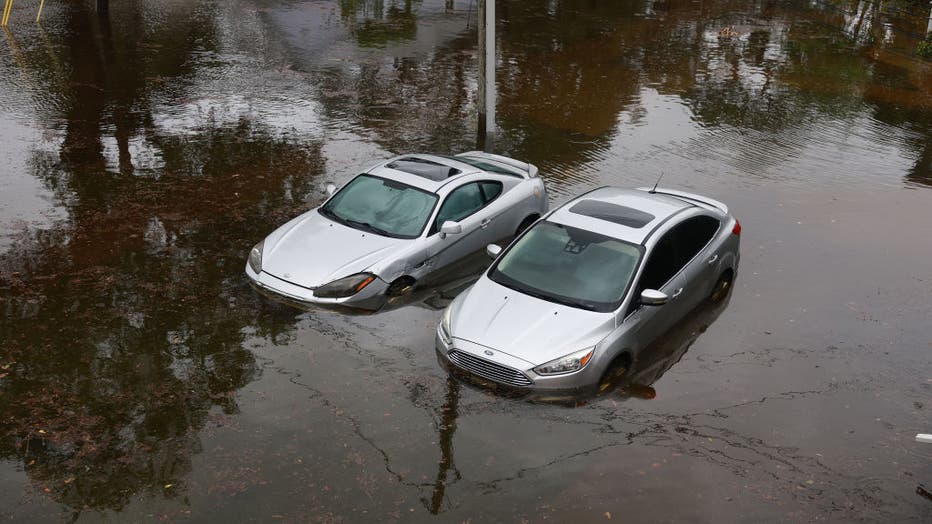How much flood water does it take to damage a car? Does it matter if it is salt or fresh?
Between hurricanes, record rains and king tides; Americans have been driving through a lot of flooding and puddles. All that water takes toll on your car. You may not realize it, but even rainwater is corrosive. Here is the difference between salt water flooding and rainwater flooding and damage to your car.
"All water can be corrosive because rainwater has acid in it, you’ve heard of acid rain," said Mike Porcelli, master-mechanic, professor of automotive technology and consultant. "So that can cause a lot of corrosion. And salt water is exponentially worse than fresh water. "
Porcelli calls himself an M.D., Machine Doctor.
Salt attacks metal
"Salt is very corrosive. It attacks metal, especially metals like aluminum, magnesium. With aluminum wheels, if they sit in salt water or even cars that park near the ocean the salt eats away," he said. "I saw a car the other day, we opened the hood the aluminum brace (under the hood) was all corroded. And I said ‘this car must live near the ocean.’"
Even salt spray off the ocean disperses salt in the air which can travel. Porcelli said that literature claims it can travel 60 miles in strong winds. He said that the side of a car parked facing the sea breeze will show wear faster than the other side.

Cars sit in flood waters from Hurricane Idalia after it passed offshore on August 30, 2023 in Tarpon Springs, Florida. Hurricane Idalia is hitting the Big Bend area of Florida. (Photo by Joe Raedle/Getty Images)
"If you have an electric car or you have a combustion engine or a hybrid; saltwater is damaging to all vehicles,"Lauren Fix, The Car Coach told FOX Weather. "And what it does is it rots out things you don't think about, like the exhaust system, brake lines and fuel lines."
She held up two brake lines. One was silver and clean. The other that was on a car in Naples, Florida that recently felt the impact of Hurricane Idalia and was ravaged by Hurricane Ian. She said the rust and corrosion happens over a very short period of time.
HERE'S WHAT TO DO AFTER YOUR CAR IS FLOODED
Failure of these lines can cause brakes to not work. Flammable fuel might be leaking instead of traveling from the gas tank to the engine.
Flooding can be catastrophic for electric vehicles
"Also, electric vehicles, saltwater is very, very corrosive. If you have an electric vehicle that has been in a flood. Do not drive it, absolutely. Don't even try to start it," Fix said. "Contact your insurance agent and let them pick it up. Take it to your local shop, see what they can do."
Several electric vehicles caught fire after Hurricane Idalia floodwater retreated.
ELECTRIC CAR IN FLORIDA CATCHES FIRE AFTER BEING FLOODED DURING HURRICANE IDALIA, FIREFIGHTERS SAY
Acid dissolved in rain water damages paint
Salt air and fresh rainwater also eat away at the paint. He said salt water is also acidic.
"It eats into the paint surface. After a rainstorm, you see the water bead up on the car and then after it dries, it leaves a little ring, Porcelli said. "And the acid will eat, it will onto the paint. And the only way to remove that is to remove some of the paint, cut down below the craters that are created by the acid."
Corrosion is only part of the issue with any water that finds its way into your car. Standing water breeds mold and mildew.
"If it (water) penetrates inside (the car) then it's going to need professional help," Porcelli advises. "Even if it's just to take the rugs out and dry them, disinfectant them and put it all back together."
He said steam cleaning, drying and disinfecting a car should run about $1,000 if caught fast. After mold and mildew set in, you may have to replace rugs and carpets. Foam in the seats will also get moldy and rot.
Electronics and water don't mix
The biggest problem with modern cars and flooding though are the electronics though, he said.
"Everything is controlled by computers. The power windows are controlled by a computer. The lights are controlled by computers. So every electronic system from the engine to the transmission, tail lights, even the radio is controlled by computers" Porcelli said. "Some of those computers are down under the seats or up under the dashboard, down low. If water gets into the car and floods the floor of the car, those computers are subject to getting waterlogged."
DOES CAR INSURANCE COVER HURRICANE DAMAGE? THESE ARE THE COVERAGES YOU NEED
He said this is the reason most insurance companies will total cars that were flooded, even with no visible damage.
Driving on salt-treated roads in the snow and ice is just as damaging. Snow gets packed into the nooks and crannies under a car. Salt residue remains even after the snow melts.
Fight back
Porcelli has several tips to keep your car in shape:
- Wash your car, the sooner the better, to minimize corrosion. Some car washes have optional undercarriage spray.
- Get your car professionally cleaned and waxed once a year. Keep it clean and reapply the wax every month or two.
- Don’t drive through deep water.
- Touch-up dings, scratches and chips before corrosion sets in.
- Beware buying used cars after storms. Porcelli inspects used cars for customers before they by a car for $100-$300. He said ask around for an experienced mechanic to spot flood damage. Car Fax only catches about 85% of reported problems, he said.
Read more of this story from FOX Weather.

